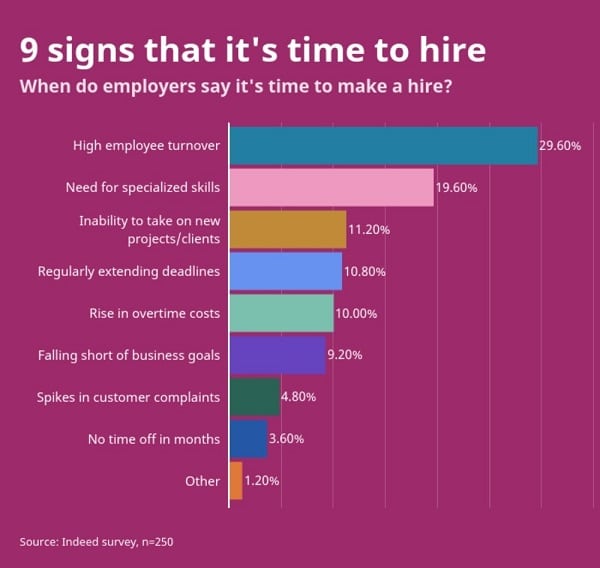If you’re starting to get overwhelmed with work, hiring a remote team might just be the best thing to do. The African proverb “If you want to go fast, go alone. If you want to go far, go together”, is indeed true. After all, there’s only so much you as an individual can achieve alone.
There are many benefits to having a remote team. Whether you hire individuals around the globe for your call center needs, engage a company specializing in outsourcing graphic design in the Philippines or tap an offshore software development team in Estonia, remote teams are generally more productive. A past study in the Harvard Business Review found that remote employees finished more than an extra day of work per week as compared to in-house employees.
Moreover, you’ll also likely have access to the brightest talent. Members of remote teams can come from all over the world. That can improve the quality of your workforce.
So, if you’re contemplating hiring a remote team and upgrading your freelance game, you’ve come to the right place. Here’s how you can grow a team from just one person–yourself:
1. Ask yourself if you need a team
You can’t just hire a remote team just because you want to. You need to ask yourself if you really need a team in the first place. You wouldn’t want to pay salaries to people you don’t even need. That would just be a waste of money. You wouldn’t want to spend too much time on hiring either if you don’t really need to do that. That would just be a waste of your precious time.
So, how do you know if you need a team? Just ask yourself the following questions: Are you unable to take on more work and are forced to say no to clients? Or perhaps you haven’t been able to get any time for yourself and are always feeling burnt out?
Consider the image below, too. The first sign, however, won’t probably apply to you:
Source: Indeed
If the answer is yes to your questions and all those other things apply, then it may be time for you to do the hiring.
If you insist on doing everything yourself, you’re more likely to make mistakes, like invoice mistakes, for example. The result? You lose out on clients.
2. Determine how many people you need
Now that you’ve established you need a remote team, it’s time to determine how many people you need.
One of the biggest blunders you can make when it comes to hiring people is getting too many onboard. While it’s understandable why you want to grow a team and consider the maximum number of job candidates, you need to consider quality over quantity. There is simply no point in hiring a team of five for instance, if a team of three can get the job done efficiently as well.
To determine how many you need, just make a list of things you usually do. Then pick which ones you’d rather let someone else do for you.
Are you spending too much time creating those graphics for your articles so you end up writing less content in a week? Then it might be time to hire a graphic designer. Do you make frequent mistakes invoicing? Then, hire your own accountant to do the job.
The key is to be strategic. Don’t just come up with a number of people to hire. Your final number should be data-driven.
3. Hire
Hiring your first employee can be daunting. You desire the same level of dedication you have. Sometimes it can be hard to determine how much someone is willing to give without actually working with them. Furthermore, there are different hiring strategies, so it can be difficult to choose the one that works best for the first time.
But recruitment doesn’t actually need to be that complicated.
Remember when I said you should come up with a list of things you’d rather have other people do? Well, on that same list, just specify the qualifications you’d like each of those employees to have. If you’re hiring a graphic designer, for example, how many years of experience should the successful candidate have? If you’re hiring a content writer, what type of writing should that person be able to do?
Next, check if they have worked in small teams before or have a solid background in working in a dynamic environment. See, too, if they’ve ever led a team. You might need a suitable team leader to lighten your load and share responsibilities in the future. Also, you might want to check if they have experience in remote work.
Consider having an in-depth job interview where both parties can ask questions or clear out any concerns.
4. Pick a communication channel
Let’s say you already have your team. Congratulations! Now it’s time to determine how you will communicate with them.
Remote teams, after all, need to have consistent and seamless communication. As a business owner, you must ensure your remote team gives you updates on projects regularly and meets pending deadlines efficiently.
You should also give them the guidance they need to perform. For instance, you might need to offer your content team detailed content style guides to help them live up to your company’s standards and meet clients’ needs.
The good news is, there are many communication tools at your disposal. Zoom and Google Meet, for instance, are popular platforms. Studies have found that around 43 percent of remote teams make use of video conferencing software– that’s almost half!
Source: Brid.tv
There are other communication tools you can use. Email, for instance, is still widely-used. If you decide to use this, though, make sure you specify how quickly your employees should respond to emails. Should they respond in an hour? Are they required to reply during weekends, too?
You can have more than one communication channel for your remote team. For example, you can use Zoom for your weekly video conferencing calls. But for assigning tasks, you can use email. That way, your employees can always go back to your written instructions if something was not clear. Do you have employees working in shifts?
Use online tools to help them with scheduling processes like shift swaps. Having a dedicated platform for scheduling will help you keep other channels clear.
Make sure all your employees get the memo on which communication channel/s to use in the end.
5. Organize your first team call
You can’t just expect your team employees to know what to do right after you hire them. Sure, your content writer knows they have to write articles. But they won’t know how many articles they’d need to write in a day, for instance.
In other words, it’s best to lay down your expectations from the get-go.
Schedule a team call with your remote team. During the call, specify each person’s individual goals. Then explain the team goals you have in mind.
When you decided to branch out and grow a team, you also probably had a vision in mind of what you’d like your brand to become in the coming years. One of the most effective ways of making your vision into a reality entails having a workforce that reflects it.
So, communicate your vision to your employees as well.
Sharing your vision will also offer your remote workers a sense of comfort and pride, especially if your vision and company values align with theirs. They’ll know exactly what they signed up for and will strive to perform better.
Bottom Line
Building a remote team from scratch is far from easy. But once you find the right people, you’ll see your business flourishing greatly. You’ll witness an influx of clients, an increase in revenue, and greater productivity levels. The best part is, you won’t be doing it all alone.
One shouldn’t shy away from getting help when need be. After all, we’re only human. Nobody should have to compromise their mental or physical well-being to great extent to have a successful business.
So, do your research and hire the right people. You’ll see your brand make its mark amongst its competitors.
Photo by Fakurian Design on Unsplash








Leave A Comment